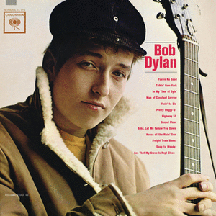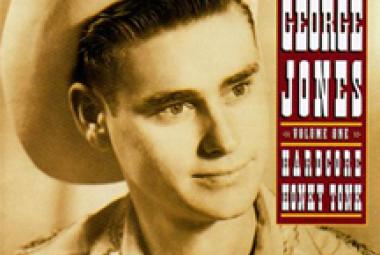Bob Dylan is the eponymous debut album of American singer-songwriter Bob Dylan, released on March 19, 1962 by Columbia Records. Produced by Columbia’s legendary talent scout John H. Hammond, who signed Dylan to the label, the album features folk standards, plus two original compositions, “Talkin’ New York” and “Song to Woody”. (More from Wikipedia)
As to his Christian period, I have already mentioned the Biblical imagery in “When the Ship Comes In”. The opening verse of the title track, “Highway 61 Revisited” on Highway 61 Revisited is a hip retelling of God’s command that Abraham sacrifice his long-awaited son Isaac. One of the songs on his very first album, Bob Dylan is a traditional folk song called “Gospel Plow”. So none of this is brand new either as I see it.
The first Bob Dylan album, Bob Dylan was released with great fanfare by Columbia Records in March 1962; it is a relatively conventional folk album that is not unlike those that Joan Baez, Judy Collins, and Peter, Paul and Mary were recording at the time, with just two original songs. The album was produced by John H. Hammond, the legendary talent scout who signed Bob Dylan to Columbia. Though excellent in every way – for instance, the album includes “Man of Constant Sorrow”, the song (as performed by the Soggy Bottom Boys, with George Clooney on lead vocals) that was made famous in the 2000 Coen Brothers film O Brother Where Art Thou – Bob Dylan sold just 5,000 copies initially; and Columbia Records executives began grumbling about Dylan’s being “Hammond’s folly”.
* * *
It was clear that Bob Dylan’s second album would be very different from Bob Dylan, where only two original songs were presented. Wikipedia notes: “Many critics have noted the extraordinary development of Dylan’s songwriting immediately after completing his first album. Dylan biographer Clinton Heylin connects the sudden increase in lyrics written along topical and political lines to the fact that Dylan had moved into an apartment on West 4th Street with his girlfriend Suze Rotolo in January 1962. Rotolo’s family had strong left-wing political commitments; both of her parents were members of the American Communist Party. Dylan acknowledged her influence when he told an interviewer: ‘Suze was into this equality-freedom thing long before I was. I checked out the songs with her.’” That’s Suze Rotolo on Bob Dylan’s arm in the front cover shot of The Freewheelin’ Bob Dylan, walking down a snowy Greenwich Village street.
(June 2013/2)
* * *
For one thing, Bob Dylan often used Biblical imagery in his songs. One obvious example is one of his loveliest songs, “Knockin’ on Heaven’s Door”, which is taken from the soundtrack of Pat Garrett & Billy the Kid (1973). On his very first album, Bob Dylan (1962), the first song on Side 2 is “Gospel Plow”.
* * *
Since 2012 marked the 50th anniversary of the release of Bob Dylan’s first album, Bob Dylan, a re-examination of his multi-faceted career was taking place.
(August 2014)
* * *
But solo songwriting is a lonely profession, and success is far from guaranteed. Bob Dylan’s first album, Bob Dylan did not particularly showcase Dylan’s songwriting talent; there were only two original songs on the album. and the tunes to both had similarities with his mentor Woody Guthrie’s songs. In fact, says Wikipedia: “Mitch Miller, Columbia [Records]’s chief of A&R at the time, said U.S. sales totaled about 2,500 copies. Bob Dylan remains Dylan’s only release not to chart at all in the US, though it eventually reached #13 in the UK charts in 1965. Despite the album’s poor performance, financially it was not disastrous because the album was very cheap to record.” Bob Dylan was one of the first Dylan albums that I purchased, and I am astounded that this album never made the charts.
* * *
Since I only have Cry of the City thus far, I have Phil Gammage’s playlist on from his website, www.philgammage.com. Just one great song after another; they are mostly original songs, but one is a cover of “Baby, Let Me Follow You Down”, a traditional folk song that Bob Dylan included on his first album that I discussed earlier, Bob Dylan; another standpoint is an instrumental guitar-driven track called “Royal Flush”. (Two of Phil Gammage’s solo albums have been all instrumentals).
(March 2015)
* * *
As I wrote about Bob Dylan in my last post, his first album, Bob Dylan sold modestly; and Dylan became known as “Hammond’s Folly” around Columbia Records – John H. Hammond had decided to sign Dylan on the spot after hearing him perform on September 14, 1961 at the apartment of Carolyn Hester and Richard Fariña (two folksingers that I also wrote about last month), though he evidently made a formal audition first (no recorded evidence of that audition survives, unfortunately).
(April 2015/1)
* * *















